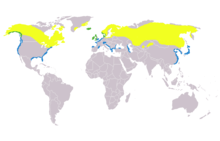Red-breasted merganser
| Red-breasted merganser | |
|---|---|
 | |
| Male in winter at New Jersey, USA | |
 | |
| Female, Ottawa, Canada | |
| Scientific classification | |
| Kingdom: | Animalia |
| Phylum: | Chordata |
| Class: | Aves |
| Order: | Anseriformes |
| Family: | Anatidae |
| Subfamily: | Merginae |
| Genus: | Mergus |
| Species: | M. serrator |
| Binomial name | |
| Mergus serrator Linnaeus, 1758 | |
 | |
| Red-breasted merganser range Breeding range Year-round range Wintering range | |
| Synonyms | |
|
Merganser serrator | |
The red-breasted merganser (Mergus serrator) is a diving duck, one of the sawbills. The genus name is a Latin word used by Pliny and other Roman authors to refer to an unspecified waterbird, and serrator is a sawyer from Latin serra, "saw".[2]
Taxonomy
The red-breasted merganser was originally described under its current scientific name by Linnaeus in his 18th-century work, Systema Naturae.[3]

Description
The adult red-breasted merganser is 51–62 cm (20–24 in) long with a 70–86 cm (28–34 in) wingspan.[4] It has a spiky crest and long thin red bill with serrated edges. The male has a dark head with a green sheen, a white neck with a rusty breast, a black back, and white underparts. Adult females have a rusty head and a greyish body. The juvenile is like the female, but lacks the white collar and has a smaller white wing patch.
Voice
The call of the female is a rasping prrak prrak, while the male gives a feeble hiccup-and-sneeze display call.
Behaviour
Food and feeding
Red-breasted mergansers dive and swim underwater. They mainly eat small fish, but also aquatic insects, crustaceans, and frogs.
Breeding
Its breeding habitat is freshwater lakes and rivers across northern North America, Greenland, Europe, and Asia. It nests in sheltered locations on the ground near water. It is migratory and many northern breeders winter in coastal waters further south.
Speed record
The fastest duck ever recorded was a red-breasted merganser that attained a top airspeed of 100 mph while being pursued by an airplane. This eclipsed the previous speed record held by a canvasback clocked at 72 mph.[5]
Conservation
The red-breasted merganser is one of the species to which the Agreement on the Conservation of African-Eurasian Migratory Waterbirds (AEWA) applies.
References
- ↑ BirdLife International (2012). "Mergus serrator". IUCN Red List of Threatened Species. Version 2013.2. International Union for Conservation of Nature. Retrieved 26 November 2013.
- ↑ Jobling, James A (2010). The Helm Dictionary of Scientific Bird Names. London: Christopher Helm. pp. 251, 354. ISBN 978-1-4081-2501-4.
- ↑ Linnaeus, Carl (1758). Systema naturae per regna tria naturae, secundum classes, ordines, genera, species, cum characteribus, differentiis, synonymis, locis. Tomus I. Editio decima, reformata (in Latin). Holmiae [Stockholm]: Laurentii Salvii. p. 62.
- ↑ Jonsson, Lars (1992). Birds of Europe with North Africa and the Middle East. Princeton University Press. p. 118. ISBN 0-691-03326-9.
- ↑ "The Need for Speed". www.ducks.org. Ducks Unlimited. 7 May 2007. Retrieved 14 December 2015.
External links
| Wikimedia Commons has media related to Mergus serrator. |
| Wikispecies has information related to: Mergus serrator |
- Red-breasted Merganser Species Account – Cornell Lab of Ornithology
- Massachusetts Breeding Bird Atlas - Red-breasted Merganser
- "Red-breasted merganser media". Internet Bird Collection.
- Red-breasted merganser photo gallery at VIREO (Drexel University)
